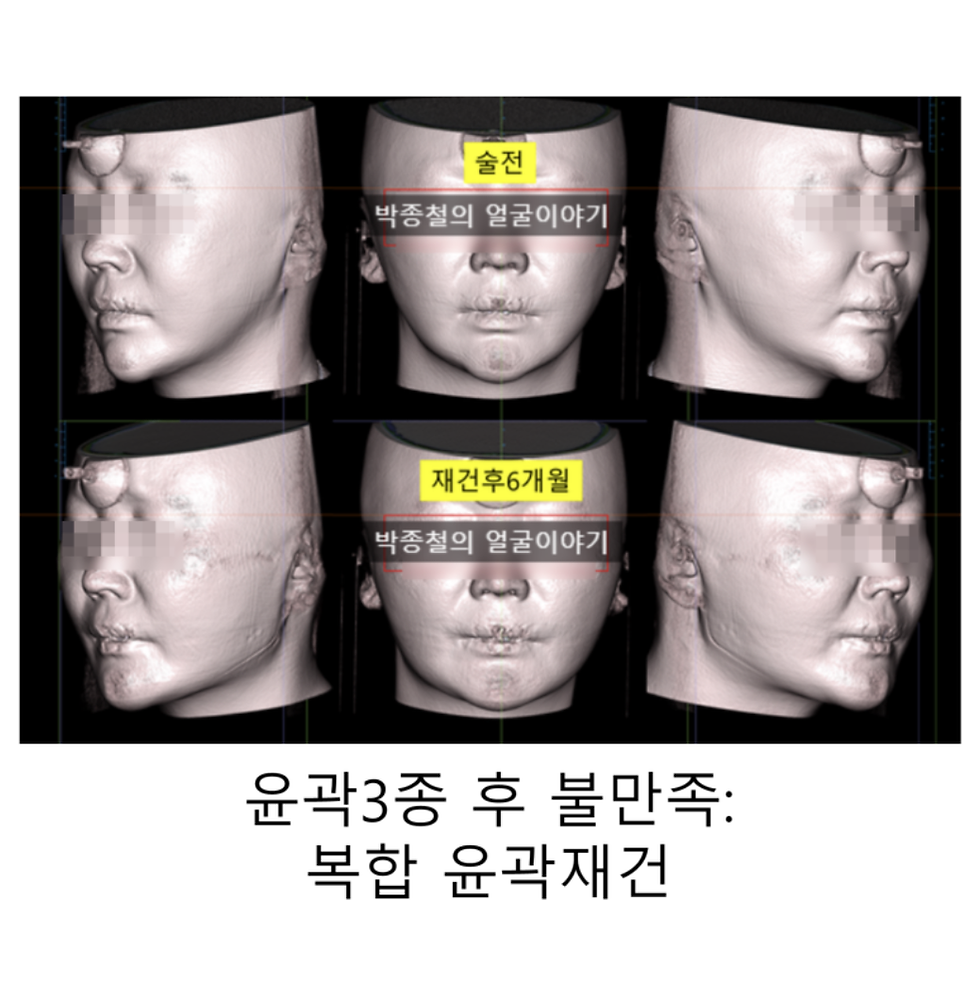Analysis of Combined Surgery-First Orthognathic Surgery and Facial Contouring Results Using Before-and-After Images
- Dr. Park

- Apr 16
- 3 min read
Greetings. I am Dr. Park Jong-cheol, an Oral and Maxillofacial Surgeon.
This article provides an objective analysis of a patient case involving surgery-first orthognathic surgery combined with facial contouring procedures (mandibular angle reduction, zygoma reduction, and genioplasty). We will review the surgical planning process and the actual outcomes by examining before-and-after orthognathic surgery images..
Pre-operative Patient Condition and Analysis

Prior to surgery, the patient presented with mandibular prognathism (an underbite), characterized by a protruding lower jaw. Features such as a thick lower lip and horizontal lip corners contributed to a somewhat expressionless or stern appearance. This could occasionally lead to misunderstandings in daily life. Correcting the underbite through orthognathic surgery can naturally elevate the lip corners, contributing to a softer facial impression.


CT analysis confirmed the anterior positioning of the mandible relative to the reference line. A habit of excessive chin muscle tension to achieve lip closure was also observed.

Furthermore, facial asymmetry was noted, with the maxillary dental midline deviated 1.44mm to the right and the chin midline deviated 0.58mm to the right.
Orthognathic surgery involving vertical repositioning of the maxilla was deemed necessary to address these issues. Following consultation with the patient, the decision was made to proceed with surgery.
Surgical Plan: Surgery-First Orthognathic Surgery and Facial Contouring Triad
After thorough consultation, a surgery-first orthognathic surgery approach was chosen, meaning the surgery was performed before orthodontic treatment. The specific orthognathic surgery plan aimed to induce mandibular setback by repositioning the maxilla posterosuperiorly.
Orthognathic Surgery Plan:
Maxillary central incisors: Planned movement of 1.5mm left / 3mm superior / 2.5mm posterior.
Maxillary first molars (#16/#26): Planned superior movement of 6.2mm / 5.8mm respectively.
A point: Planned anterior movement of 0.5mm.
Estimated total posterior movement of the Pogonion (chin point): 9.39mm.
Concurrently, facial contouring procedures were performed to improve overall facial balance and contour.
Facial Contouring Plan:
Genioplasty (T-osteotomy): 5mm width reduction while maintaining the original length and anteroposterior position.
Mandibular angle reduction: Smooth reduction while preserving an appropriate angle below the ear.
Zygoma reduction: Reduction of both the 45-degree (anterior) and lateral zygoma, including superior fixation.
Post-operative Changes: Before-and-After Orthognathic Surgery Evaluation via CT and Photos
Post-operative changes were evaluated using CT scans and photographs taken 6 months after the surgery, allowing for a clear before-and-after orthognathic surgery comparison.

CT Results: Measurements indicated that the maxilla itself moved superiorly by 3.26mm. However, due to the rotational effect applied during the orthognathic surgery, the actual vertical facial length decreased by approximately 6mm.

양악선수술 및 안면윤곽 3종 CT분석 Notably, despite a significant mandibular setback exceeding 9mm, a smooth jawline was maintained without noticeable sagging of submental tissues.

양악수술 후 턱밑살 변화 Photographic Comparison: Comparing the frontal before-and-after orthognathic surgery photographs clearly reveals significant improvements in overall facial proportions and impression, leading to a more refined and balanced appearance. The patient reported satisfaction with the aesthetic outcome and receiving positive feedback in daily life.

양악수술전후 이미지
Conclusion
This case involved performing surgery-first orthognathic surgery for underbite correction simultaneously with facial contouring procedures (mandibular angle, zygoma, and chin reduction) to achieve both functional and aesthetic improvements. Comparing before-and-after orthognathic surgery images serves as essential data for objectively evaluating surgical outcomes and visually confirming patient satisfaction. This case demonstrates how such combined procedures can effectively correct facial skeletal disharmony and result in positive transformations in overall appearance.
Analysis of Combined Surgery-First Orthognathic Surgery and Facial Contouring Results Using Before-and-After Images



Comments